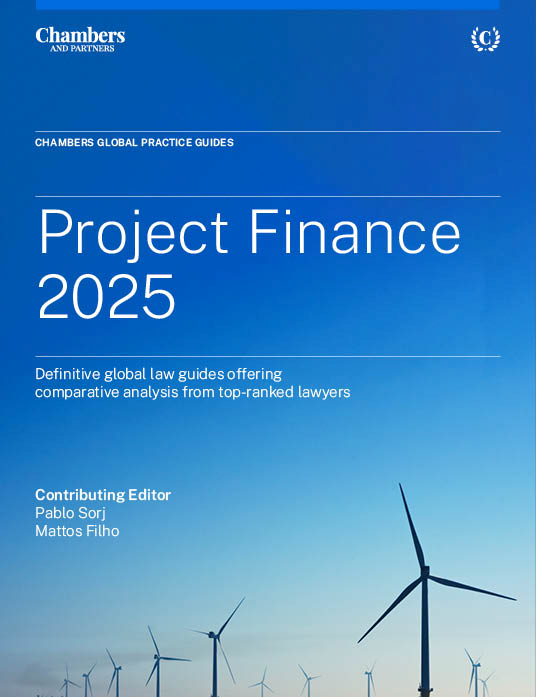
Project Finance 2025
The Project Finance 2025 guide features over 20 jurisdictions. The guide provides the latest legal information, as it applies to project finance, on public-private partnership (PPP) transactions, guarantees and security, judgments of foreign courts, foreign investment, structuring and documentation considerations, bankruptcy and insolvency, insurance, tax, and project and financing agreements.
Last Updated: November 04, 2025
Compare law and practice by selecting locations and topic(s)
Select Locations

Select Topic(s)

Please select at least one location and one topic to use the compare functionality.
An Overview of Developments in Project Finance Around the World
In recent years, the number of participants in global project finance markets has increased notably, as a wider range of lenders and sponsors – located in various parts of the world – have become active players.
The capacity to fund large-scale projects, coupled with historical experience in cross-border transactions, has led commercial banks to act as a traditional source of financing. However, the financial crisis and the changes in the financial regulatory framework (eg, the Basel III standards) have limited the availability of credit. Together, this has brought multi-sourced financing for commercial banks into the main structure, filling the funding gap worldwide.
This means that large-scale projects are now financed using more sophisticated and complex financial and legal instruments, provided by a diverse set of public and private institutions. In recent years, the diversity of market participants has risen, encompassing capital markets investors, export credit agencies (ECAs), multilateral development finance institutions and government lending institutions.
Notwithstanding this increased complexity, a combination of local market expertise, sound commercial structures (and relationships), due diligence and robust security packages has helped to ensure that the new structures are used effectively.
Moreover, global economic growth and the consequent increased demand for energy have become a major driver for capital investment; this is especially the case in fast-growing countries. In emerging markets, despite the political uncertainty and tighter fiscal policies, the flows from developed financial markets have driven the search for yields.
In 2024, the expansion of solar power surpassed that of wind energy, primarily driven by a significant reduction in solar panel prices. This dynamic is expected to persist, positioning solar power as the leading contributor to new energy supply. Projections indicate that solar will account for approximately half of the global increase in electricity demand by 2025, reinforcing its role as a central pillar in the energy transition and a key focus for project finance activity worldwide.
Digital infrastructure continued to attract strong interest from project finance players recently, reflecting the sector’s growing importance in the global economy. Data centres, in particular, have emerged as a prominent asset class, supported by rising demand for AI and cloud computing services. The project finance market has responded with innovative structures and a broader range of debt investors, including those willing to take on construction risk. As digital infrastructure remains a key enabler of technological advancement, it is expected to remain a focal point for project finance activity, with ongoing attention to market dynamics and credit fundamentals.
Required investments and results
The need for remarkable projects and innovative deals worldwide has dominated the headlines in recent years. By way of example, the Asian Development Bank estimated that investment in infrastructure in Asia must add up to approximately USD1.7 trillion per year by 2030 in order to maintain growth momentum, tackle poverty, and respond to the issue of climate change.
In 2017, the McKinsey Global Institute released a report assessing the worldwide demand for increased infrastructure investment. This report estimated that, from 2017 to 2035, the world must invest USD3.7 trillion a year in economic infrastructure (such as transportation, power, water and telecommunications systems) in order to support rates of growth. The report further estimates that emerging economies will demand approximately 63% of that amount.
According to data from IJGlobal, global project finance loans in 2024 totalled USD799.16 billion of financial closes, registering an increase compared to 2023. In 2024, the refinance of project finance debt for 2024 amounted to USD191.45 billion – an increase of 54.3% when held against project finance refinance activity from 2023.
Europe project finance loans totalled USD225.53 billion in 2024 – an increase of 11.21% against 2023, when USD202.79 billion was achieved. The most active regional project finance sectors were renewable energy and telecommunications.
North America project finance loans in 2024 reached USD335.66 billion from 647 deals. The most active infrastructure finance sectors by value were oil and gas at USD236.6 billion, followed by power at USD172.32 billion and telecommunications at USD167.19 billion.
Latin America project finance loans in 2024 registered an increase when compared to 2023. Loans amounted to USD73.39 billion in 2024.
Asia-Pacific project finance loans in 2024 were lower when compared to 2023, with loans amounting to USD100.07 billion of closes. The most active sector was renewable energy.
The climate bond financing market has seen an increase in 2024. In 2024, climate-aligned issuance rose to USD1.1 trillion. In addition, the climate bonds deals were priced in several currencies, indicating a global presence of this type of instrument.
Outlook
Although it is difficult to predict how the markets will react, particularly given concerns about political events and their impact on the global economy, the demand for infrastructure projects is as high as ever. As such, the growth of major project financing is likely to continue.
It is clear that structuring project finance that includes multiple funding sources is becoming more complex every year. It is therefore key for market participants (including lawyers) to be fully familiar with market trends and a diverse pool of businesses and risks associated with the projects.
Despite all recent results and developments, project finance has frequently proved to be a resilient way to fund infrastructure projects. Therefore, it remains one of the main sources of funds worldwide and there is no reason to believe that this will cease to be the case in the near future.

